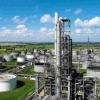|
|

High Pressure Line, Low Pressure Sample Loop -
#1

Posted 24 May 2012 - 12:48 PM
I'd be grateful of some advice.
I have crude oil in a high pressure pipeline.
The pressure is above the pressure the analyser can handle.
I am considering putting a pressure reducing valve in the fast loop (20l/min) to drop the pressure to a safe value for the analyser.
But I seem to have no option but to return the sample flow to the main pipeline. I am too far from the pipeline pumps to return to the main pipeline pump inlet and a storage tank for the sample flow is equally out of the question.
I am considering a booster pump downstream of the analyser to bring the pressur eup enough to return the sample flow to the pipeline.
So far is this feasible/realistic?
But I don't want to rely on the booster pump suction for flow, just for boosting the pressure because I am concerned that the analyser will be in a region in which between the pressure drop across the pressure reducing valve and the suction from the booster pump i may get cavitation or volatiles gassing off.
I am therefore considering a circulation pump between the reducing valve and the analyser.
Has anyone any experience of this sort of problem and any advice they can give?
#2

Posted 08 June 2012 - 08:44 AM
Following are noted in addition.
1. If analyser operates continuously, pump minimum flow had better be considered, discharging into the crude pipe. At present this is provided for (Note 1), so valves on pump discharge line should be locked opened (CSO) during operation.
2. PSV is needed, discharging into SF (safe location). If crude oil temperature is low enough, this SF could be an atmospheric tank of 20l/min*15 min=300 l = 0.30 m3 net capacity.
In this case it might be preferable to install a separate atmospheric tank (of about same capacity) downstream of analyser and pump the liquid back to the crude pipe through tank level control, acting on a discharge control valve or on the RPM of the pump. By omitting the valve downstream Analyser, PSV could be avoided on the condition that Analyser cannot be plugged by the crude.
3. If "circulation pump" means a pump just upstream Analyser (point B on scheme.jpg), this seems not to solve the problem. Design pressure downstream mentioned pump would be same as that of the crude pipe plus shutoff differential pressure of the pump. Operating pressure through Analyser would be close to operating pressure in the crude pipe (if not a bit higher).
Probably a low NPSH "booster pump", e.g. of 750 RPM, could alleviate the risk of cavitation.
Attached Files
Edited by kkala, 08 June 2012 - 09:11 AM.
#3

Posted 08 June 2012 - 05:32 PM
Valuable as always.
I must say I rather like the idea of the atmospheric interceptor tank in your point 2.
This overcomes my concerns about cavitation very neatly.
This gives me some good points to ponder.
I can't see any real problems. Oh, if the pump designed to pump out the tank to the line should fail then the high level alarm can initiate a timer or be backed by another high level alarm to shut down the analyser pump and stop filling the tank.
Some good ideas to consider.
PS attached is a simple scheme I prepared for this simply to illstrate the sequence of equipment.
Attached Files
Edited by JMW, 08 June 2012 - 05:48 PM.
#4

Posted 12 June 2012 - 09:53 AM
JMW, what I don't understand is why you put a circulation pump upstream of the viscometer? You use two viscometers so that you want to get viscosity index number for your crude oil?
#5

Posted 12 June 2012 - 05:01 PM
The primary function of two viscometers is to continuously define the two constants A & B in the ASTM D341 equation:
ln.ln(v+0.7) A-B.lnT where v is kinematic viscosity in cst and T is the temperature in Kelvin.
A & B change significantly even for small changes in quality.
The heat exchanger ensures that the viscometers each measure viscosity a a different temperature which allows for real times continuous re-calculation of A & B. The heat exchanger is another reason for requiring a constant flowrate - unstable flows result in unstable heat exchange and temperature. The viscometers respond pretty much instantly to viscosity changes but temperature measurement always have a delayed response to a temperature change.
Thanks for the tip about a heater in the tank.
#6

Posted 20 June 2012 - 04:10 PM
1. Low pressure area to be protected by PSV is limited between "upstream viscometer" and "downstream viscometer" (heater included). By non placing valves between viscometers and heater, additional PSV due to "blocked" thermal crude expansion is not needed (this contingency can be covered by the first mentioned PSV).
2. Stable flow rate through viscometers is of interest, which can be more reliably implemented by a positive displacement circulation pump (instead of centrifugal), served by the single PSV mentioned.
In this case pressure reducing valve is not judged necessary, depending on the positive displacement type of the circulation pump. Advice on this point would be welcomed.
3. Additional instrumentation (TIs, PIs, FI), isolation valves and check valve may be considered.
4. A collection tank downstream of "downstream viscometer" could make operation simpler. In case that
- there are no valves between upstream viscometer and tank
- pressure at any point of mentioned low pressure area does not exceed design pressure at max crude flow through viscometers (this represents the case when crude oil main network is at design pressure)
Mentioned PSV is judged to be unnecessary, so no search for "safe location" either.
However an atmospheric tank for crude should most probably be a floating roof tank, depending on crude vapor pressure at highest operating temperature (downstream heater), http://www.cheresources.com/invision/topic/9948-storage-tank-requirements-vapour-losses. A floating roof tank of net capacity less than 0.5 m3 is needed, advice would be welcomed whether such a small floating roof tank is feasible.
5. Hoping of further clarifications / revisions from others, for the topic to be more completed.
Edited by kkala, 20 June 2012 - 04:26 PM.
#7

Posted 20 June 2012 - 08:00 PM
Your point 2) is interesting.
I guess you are suggesting that if I use a PD pump, which is the intention, this will effectively provide the necessary pressure reduction.
I am assuming that the pd pump will deliver a constant flow and that the discharge pressure is simply a function of the downstream pressure drop it must overcome to achieve that flowrate?
That's an interesting point. I'd be glad of some feedback on that.
It will mean the pump will be operated with a much higher inlet pressure than discharge pressure.
I dont' see why not, because the pump rotation is controlled by the pump and not by the upstream pressure.
PD pumps are pretty robust. If they are strong enough to burst pipes and distort casting when running against a closed head I guess they can contend with the pump effectively holding back the upstream pressure. Sort of like engine braking.
The only question this raises is the impact on the pump's internal pressure relief valve and what happens if the downstream Isolation valve is closed or fails to open at the start?
It would mean that if the downstream isolation valve is closed, the pumps internal pressure relief valve will only open when the downstream pressure is higher than the upstream pressure, which we don't want to happen.
I guess we can take care of that with a pressure switch which will shut down the pump and close the upstream isoation valve or use a manual isolation valve with a limit switch inhibiting start and with a spring check valve.... this means actuated valves with position limit switches and interlocked with the pump. But I think I may need this anyway.
If there is a chance of a blockage in ths system e.g. in the heat exchanger then I gues I need a pressure switch in the pump discharge to force a shutdown if this pressure rises too high as a result of a blockage.
Ditto if someone manually closes the downstream valve. Not sure what to expect f the pump fails to run. I guess all we'll get is the slip flow and we can use some temperature diagnostics to look for that (the low flow will result in excess heat loss in the feed to the heat exchanger if the oil temperature is above ambient, and higher than expected temperatures in the heat exchanger output.
I think I do need some back pressure on the pump at the outlet of the system to the interceptor tank anyway because I still have this concern about gassing off through the system across any high presure drop item which in this case would probably be the heat exchanger (which is also heating the oil and increasing the possiblity of volatiles gassing off).
The main pipeline has some big pressure steps depending on which pumps are used. I am wondering if I can simple include some sort of spring check, restriction ordifice or gate valve or if I need a differential regulator.
Point 3) Yes to the check valves in both parts of the system. I have temperature measurement in the viscometers. Pressure sensors or switches seem like a good belt and braces idea and I certainly think I need limits switches on the valves. Probably I need a fail close upstream isolation valve with limit switches and if I need to force a shutdown i also need to think about shutting the upstream isolation valve to protect against he pipeline pressures. A delayed close on the downstream valve or simply relying on a spring check valve will help avoiding sisolating the system with high contained pressure. The big issue here is to to make sure the pump will close and the upstream isolation valve cycle to closed in a failure situation. The limit switch on the manual islation valve at the discharge is simply to prevent start up (including opening the upstream isolation valve) with a closed downstream valve.
Next, the collection tank and discharge back to the pipeline.
Sizing of this is an interesting question and I don't have all the information I need.
(I don't have direct access to the client I can only ask questions via the distributor/system integrator).
You have suggested a capcity of less than 0.5m3.
My thought processes start with the need to avoid matching pump speeds. Instead I would go to an on/off system where the return pump runs at something above twice the analyser loop flow so if the analyser is at 20l/min the return pump would be 40l/min or greater though to some extent the available pump technologies may dictate where above my analyser flow I need to be.
This pump would thus be controlled by hi and low level switches.
Now my focus shifts to the isolation valves at the return to the pipeline. If the pump shuts down I guess I need to cycle this valve to closed. This needs to be an actuated fail close valve and maybe I also need a non-return valve to allow for the shutoff valve cycle time. I assume this is one of the check valves you suggest.
Next I need to consider what happens if any of the valves fail or the pump fails.
There are two parts to this.
First suitable interlocks to prtect the system and the impact on tank capacity.
Dealing with tank capacity this will depend on what the client needs.
If it is imperative the analyser runs all the time then the tank capacity needs to be sufficient that it can accomodate the collected flow during a suitable time period to allow for (a) service and repair where that it possible i.e. to the discharge circuit from the tank. It assumes the problem isn't the level alarms in the tank or (
So I propose to interlock the return pump and valve via valve limit switches.
I need the valve to be open or to move away from the closed position before I can start the pump. and I need to make sure the pump is shut off before the valve completely closed at the lo level alarm point. And a check valve to prevent reverse flow and I also need to prevent isolating the discharge pipe instalation with a high contained pressure.
Now what happens if the pump is signalled to start but fails? The hi alarm won't de-energise because no flow will take place so I can force a shutdown (valve close) by a time delay relay to de-energise the pump and shut the isolation valve. The check valve will prevent reverse flow due to pipeline pressure.
Level will continue to build in the tank but the pipework will be isolated allowing service.
I also then need to stop the analyser sample flow because I will run out of tank capcity and I can do that by assuming the level will continue to rise and hence the HiHi alarm can work there.
I guess I could get around valve and pump synchronisation issues by relying on the return pump's integral pressure relief valve but I am never sure to what extent one can or should rely on that as the safety feature.
Because of the high pipeline pressures I think some duplication of bakc up is in order. That is, rely on pressure relief valves as a first line of defence, but also on positive controlled actions like shutting closing the isolation valves in an appropriate sequence.
I can see this heading toward a small PLC controller, or even some simple relay logic (the crossover between hard wired relay logic and a PLC seems to be at lower and lower values these days).
So I need to do a little bit of failure mode evaluation to see what else I might need to do.
Edited by JMW, 20 June 2012 - 08:12 PM.
#8

Posted 21 June 2012 - 05:46 AM
In practice flow is not quite independent, expertise is needed to assess deviations (not same for rotary, diaphragm, plunger pumps), hence advice is welcomed.
Besides flow of e.g. a plunger pump may not be quite smooth for viscosity meters (or booster pump in case of no interceptor tank), requiring sophisticated buffering. A rotary pump may be more suitable than rest PD pumps concerning this aspect.
β1. In case of an isolation valve downstream of the PD pump, a PSV is necessary (discharging to interceptor tank?). I think that electronic switches to eliminate overpressure cannot replace PSVs. General statement on this has been read in API (most probably 521). See also post No 6, para 4.
β2. Once we had locally specified high temperature switches to stop centrifugal pumps, seeing that minimum flow line would have been connected too far. But this would not be suitable in case of blocked discharge of a PD pump.
γ. Electronic instrumentation and switches are quite useful, above indicates placing PSV(s) in addition.
δ. Mentioned "differential regulator", an option to smooth pressure variations of main pipeline, is understood to be the Pressure Reducing Valve on the attachment of post No 3. Constant flow through viscometers is understood to be the purpose of the design.
α'. The option of incipient tank may make things a bit simpler. Flow rate would be about 20 l/min (post No 1).
Acting as intermediate tank, its net capacity should be adequate for 15-20 min, that is 20*20=400 l ~0.5 m3. In case that a PSV is directed also into it, there should be additional net capacity for 15 min (time for Operator to intervene, after some alarm), thus net capacity ~ 0.8 m3.
β'. On/off level control on the incipient tank, as described (pump flow ~40 l/min), seems OK to me.
γ'. "Pump integral PRV" is not known to me, it is assumed to replace external PSV, if PRV set pressure can be adjusted to the low pressure area design pressure. This concerns the PD pump (circulation pump).
δ'. Rely on pressure relief valves as a last line of defence, but also on positive controlled actions before. A small PLC could undertake the function of numerous controls.
Edited by kkala, 21 June 2012 - 05:51 AM.
Similar Topics
Distillation Tower Top And Bottom Temperature And PressureStarted by Guest_student55_* , 27 Mar 2016 |
|
|
||
High Stack Temperature In Ccr HeatersStarted by Guest_viba0124_* , 30 Nov 2024 |
|

|
||
Steam Pressure In Heat ExchangerStarted by Guest_mvanrijnbach_* , 15 Apr 2025 |
|

|
||
Ammonia Line Vapor GenerationStarted by Guest_simadri_* , 07 Apr 2025 |
|

|
||
Critical Pressure For Choke Valve SizingStarted by Guest_Sherif Morsi_* , 07 Nov 2017 |
|

|

 FB
FB










